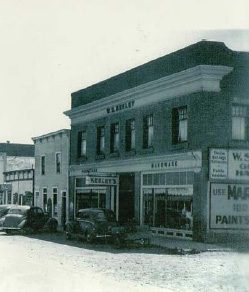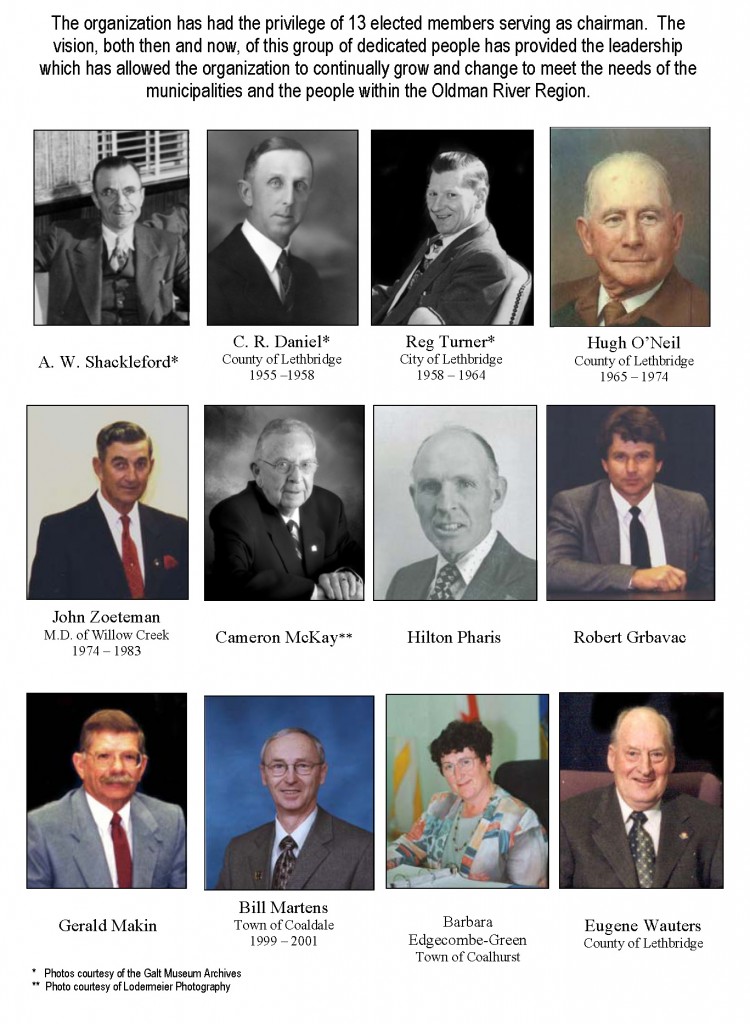History of ORRSC
ORRSC has a long history of being part of municipal planning in southern Alberta. The history of this storied organization began in 1955 and continues today.
1955-1957 – Lethbridge District Planning Commission
- The first meeting of the Lethbridge District Planning Commission was held April 20, 1955 in the council chambers of the City Hall in Lethbridge. It was attended by members from the municipalities of the Town of Coaldale, City of Lethbridge and the Municipal District of Lethbridge No. 25.
- The first planning director was Samuel Lurie of Montreal, working out of Lethbridge City Hall with a staff of 4 and an annual budget of $12,000. Between 1955 and 1956, 27 subdivision applications were processed by the commission with the basic fee to the applicant of $2.00 per application.
- The annual budget was established and each member was responsible for a portion of the required funding. The province was responsible for 50 percent of the total, while the City of Lethbridge contributed 38 percent, the Municipal District of Lethbridge contributed 8 percent, and the Town of Coaldale contributed 4 percent. Each member of the Board was paid an allowance of $10.00.
- The first members included:
Alfred W. Shackleford, City of Lethbridge (Chair), Clifford J. Black, City of Lethbridge, Thomas R. Haig, City of Lethbridge, Charles R. Daniel, County of Lethbridge, Harold G. Houlton, County of Lethbridge, Earl J. Foxall, Town of Coaldale.
1957-1963 – Oldman District Planning Commission
 There were many changes for the Commission in 1957 including the addition of the Town of Picture Butte and a new name to reflect a regional approach. S.J. Clarke took over the role of planning director and the Commission office moved to better accommodations in City Hall in January of 1958. In September of 1957, the Commission met for the first time as the Oldman River District Planning Commission.
There were many changes for the Commission in 1957 including the addition of the Town of Picture Butte and a new name to reflect a regional approach. S.J. Clarke took over the role of planning director and the Commission office moved to better accommodations in City Hall in January of 1958. In September of 1957, the Commission met for the first time as the Oldman River District Planning Commission.
The change of name signified both a change in general policy in as much that it was a recognition of the premier interest of the Commission in regional development. As well, the name was in part to dispel the perception that the surrounding municipalities would be dominated by the City of Lethbridge. In November 1957, member Earl Foxall sponsored a resolution that “this commission adopt a policy which will create conditions in the physical, social and economic development of South-West Alberta to allow the fullest possible use to be made of its rich natural resources, ….” .
During that same meeting, it was asked how it was intended to bring about interest in planning in areas bordering the boundaries of the present district. In response, the Director stated “it was his opinion that adjoining areas should not be invited to join, but rather that, by work done by the Commission, their interest should be aroused to the extent that they ask to be brought into the District.“
1963-1995 – Oldman River Regional Planning Commission
 In 1963, the provincial government established the Alberta Planning Act and as a result, many changes followed. The organization was now known as a Regional Planning Commission, one of several created for different regions in Alberta.In 1963, the member municipalities had grown to 11, the budget was over $65,000 and there were now 9 employees.
In 1963, the provincial government established the Alberta Planning Act and as a result, many changes followed. The organization was now known as a Regional Planning Commission, one of several created for different regions in Alberta.In 1963, the member municipalities had grown to 11, the budget was over $65,000 and there were now 9 employees.
By 1972, all municipalities in the region were required to become a member of a planning commission and as a result, the following years saw membership grow to eventually include all 41 municipalities and representatives from both First Nation Reserves.
Between 1963 and 1995, the Planning Commission continued to grow under the guidance of several directors including D.A. Thomson, E.P. Adderley, J.E. Hartley, L.O. Smith and L. Paterson. The office moved from City Hall in July of 1970 to an office across the street at 1003 4 Avenue South. Another major relocation occurred the spring of 1976, when the Commission took up residence at 905 4 Avenue South and occupied, at times, the second floor as well as space in the basement.
1996-2002 – Oldman River Intermunicipal Service Agency
“As of March 31, 1996, the Commission was dissolved by the Minister of Municipal Affairs, the Hon.Tom Thurber.” Annual Report 1995-1996
After 33 years, the Oldman River Regional Planning Commission was dissolved and a new chapter in regional planning in southern Alberta began. To maintain consistency, quality and regional perspective in planning services, 32 of the former 41 member municipalities committed to establishing an intermunicipal service agency and ORISA was born.
Coordinating Manager Tom Golden, now oversaw a staff of eight employees and an operating budget of $325,000 and took up the challenge of establishing a new way of providing planning services to the membership. Staff was very busy in the late 1990s and early 2000s preparing 53 statutory plans for ORISA members.
In 2002, ORISA partnered with 18 of the urban municipalities to establish a regional Geographic Information System (GIS). The outstanding project received funding as a pilot project, the only project to qualify that year. Since its inception, the GIS program has grown to include three more municipalities and has been awarded an Honorable Mention for the Minister’s Award for Municipal Partnership.
2003-Present – Oldman River Regional Services Commission
In 2003, planning in southern Alberta was once again the responsibility of a commission. Member municipalities proposed to create a regional services commission in order to address property and liability issues. The need to be able legally hold property was in part the result of realizing that the staff had outgrown the their current accommodation in the basement of the County of Lethbridge building.
So, after 27 years and much thanks to the County of Lethbridge, the Commission packed up and moved across the city to 3105 16 Avenue North in January of 2003. In October of 2003, Order in Council No. 464/2003 officially created the Oldman River Regional Services Commission. The Oldman River Regional Services Commission now contracts with 39 member municipalities and employs 18 staff.
Former Chairs
(click image to enlarge)



